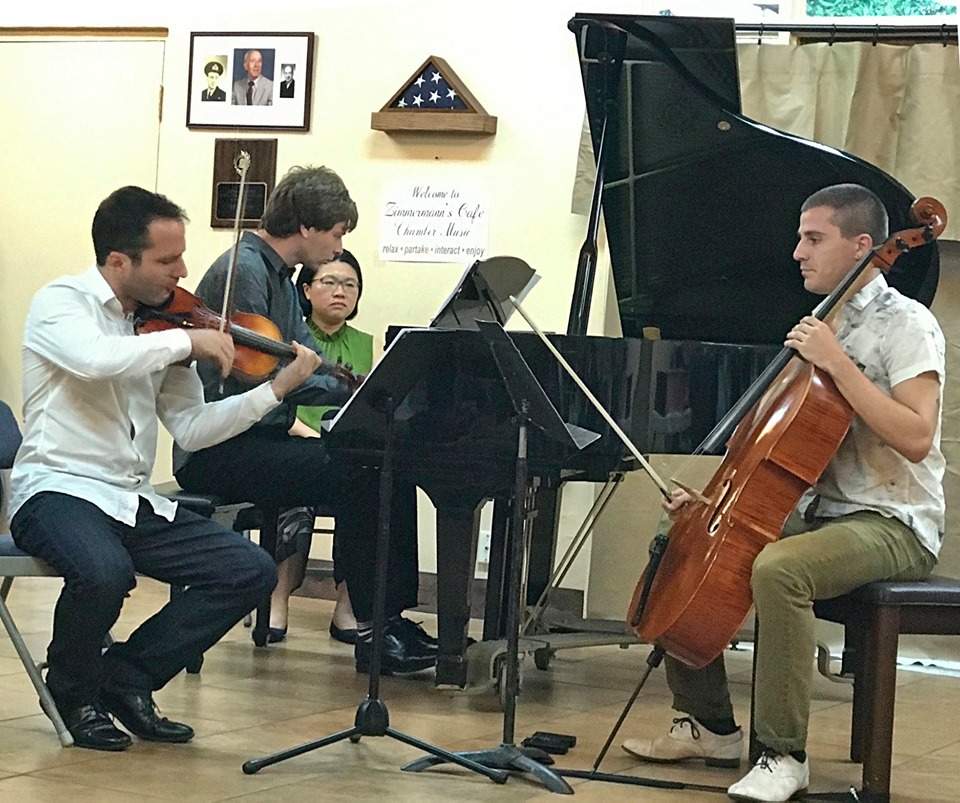
By Dennis D. Rooney
The attendees of Zimmermann’s Café Chamber Music (whose motto is “Music Written Today; Composers Here and Now,”) are an amiable group who gathered patiently in the quiet space of St. Andrew’s on Oct. 27 to wait until the doors of Frazell Hall (a/k/a social hall or fellowship hall) opened at about 3:45 p.m., whereupon they took seats at about a dozen banquet tables surrounded by folding chairs, then proceeded to the tables of food located on the south wall of the room, filled their plates and returned to their seats to wait for the program to begin shortly after 4 p.m.
This was the opening of the fourth season of a series devoted to presenting “the music of South Florida composers in a casual environment that encourages friendly conversation between composers, performers, and listeners.” Works of five composers ranging in age from 26 to 93 were performed by 11 players. Each composer made some prefatory remarks.
Morgan Denney (b 1993) introduced White-Knuckling for solo cello, performed by Trace Johnson. The composer called it “an interior monologue interrupted by ‘curve balls’ suggesting life’s many uncertainties.” Although a violinist herself, Denney wanted the cello “because it growls.” Johnson played it impressively, managing the music’s stressful moments with mastery. As it made its way to a shuddering diminuendo conclusion, I thought I heard a fleeting quotation from Strauss’s Don Quixote.
Marshall Turkin (b 1926) was the senior composer of the group. He wrote his Sonata for Alto Saxophone and Piano in the late 1940s, when he was studying with Peter Mennin at the Juilliard School. He was playing the alto sax professionally at the time and wanted to write a work that would explore its unique qualities. He showed it to Sigurd Rascher (1907-2001), a legendary virtuoso, who not only played the first performance at Interlochen but also arranged for the work’s publication.
As played by saxophonist Dannel Espinoza and pianist Sheng-Yuan Kuan, the sonata proved to be a well-made three-movement work written in a cosmopolitan style. The first movement, bright and busy, leads to a solemn slow movement that has the character at least in part of a chaconne. In the finale, the energy of the opening movement returns but contrasted with slower, more lyric material. The composer warmly thanked the performers, calling it the “best I have ever heard it played.”
Clare Shore (b 1954) is a Zimmermann’s co-founder. Her Intensities of Degrees (2018) for three flutes was in fact performed by two of the original three commissioners, Misty Theisen and Cathie Apple, with pianist Jennifer Reason. In her prefatory remarks, the composer described the work as based on the theme of temperatures.
“White Heat” describes the white glow of superheated steel; “Glacial Blue” evokes frigid temperatures. The drip of melting ice connects the movement with the final Ecco la verde (“Behold Spring”) that depicts thawing, awakening from hibernation, birdsong, and includes a quotation from a ballata of the same name by the Italian trecento composer Francesco Landini (c 1325–1397). The three movements are springboards for a variety of flute sonorities, both traditional and “extended,” employing flute, alto flute and piccolo.
In order to employ two flutists instead of three, material was redistributed. Beginning with almost inaudible sounds, the second movement is replete with multiphonics, extra-musical knocks and the use of the flute’s head joint alone. The finale, which follows attacca, is more relaxed in character. Even those who may have disliked the sound of some of the extended techniques had to acknowledge the consummate virtuosity of the performers.
Olivia Kieffer (b 1980) introduced Nobility of Homophones II as a reworking of an earlier version for two toy pianos played by one performer, revised for two toy pianos played by two performers. The title comes from a witty rejoinder to a question about “rows” and “rose.” The music nods in the direction of Philip Glass (perhaps Terry Riley, also) but the special sonority of the two toy pianos and their random tuning also suggested a Balinese gamelan. It was a lighthearted work but timbrally intriguing in the dissimilar quality of the two instruments. The composer was joined by pianist Logan Rutledge.
The Piano Trio No. 2 by Frederic Glesser (b 1956), a work from 2018, brought the program to a close, in a first performance by pianist Sergei Skobin, violinist Yordan Tenev, and cellist Trace Johnson. The composer suggested in his introductory remarks that this was the most successful of the several piano trios he has written to date.
It was an effective work, seemingly cast in three movements played without pause. Piano and cello shared most of their material, much of it lyric, while the pianist pursued a rhythmic foundation. The players were superior collaborators, producing a tonal sum that enriched the musical materials.